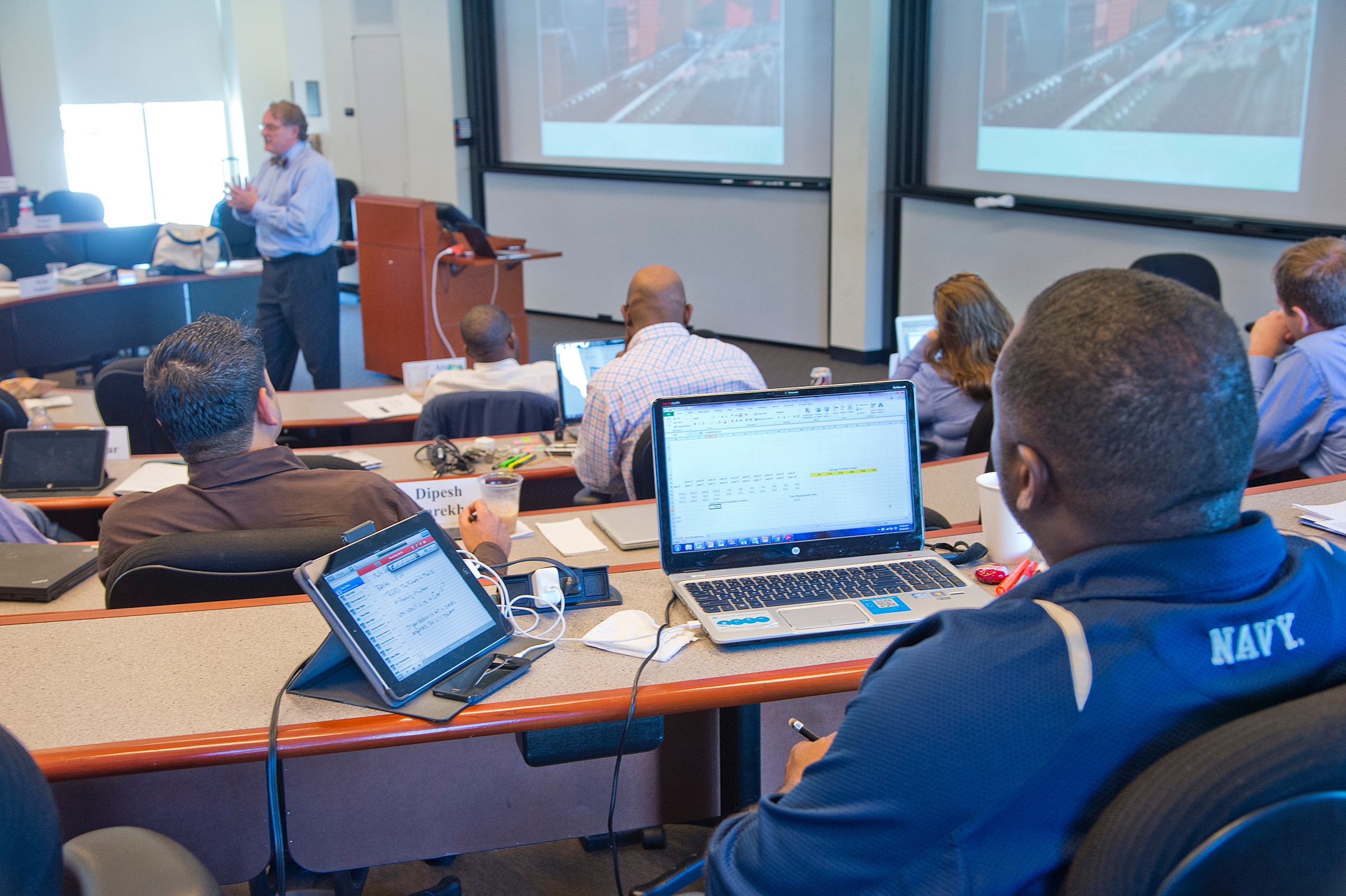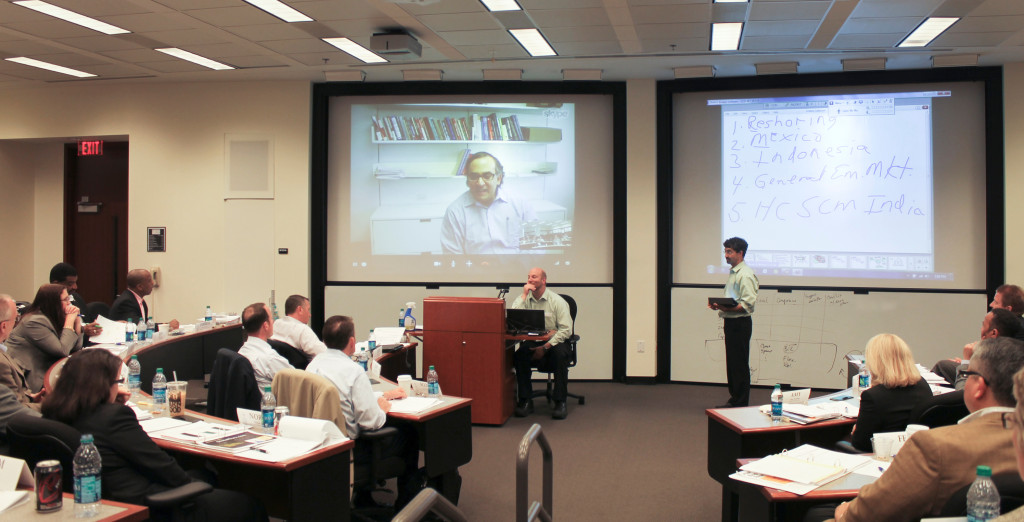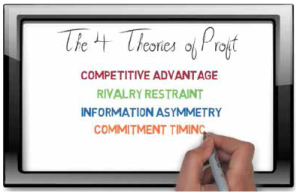

Business education is in the throes of a historic transformation. Changes driven by technological advances and the corresponding demands of business are affecting how students learn, how professors teach, and how schools both organize and market themselves. For their part, Goizueta faculty are embracing technology to bring their creativity to bear in the classroom, be it physical or virtual. Armed with a growing number of innovative options, they are enhancing the in-class experience, collaborating with colleagues at other institutions to stay current with industry best practices, and creating courses that enable students to excel in the use of digital tools.
A Competitive Edge
The adoption of technology is often spurred by necessity. Disruptions in the marketplace follow, leading to innovations that can quickly change the ways business is done—and taught. Goizueta’s creation of the modular executive MBA format, for example, arose as a result of the school’s growing global presence and the need to remain competitive among leading business schools. Goizueta tapped faculty like Ed Leonard, associate professor of marketing, and Richard Makadok, associate professor of organization and management, to explore a range of academic technologies as they helped position the school in the quickly expanding arena of distance learning.
Voice-over PowerPoints, an early format for online delivery of academic content, are still a commonly used tool in distance learning, but Goizueta’s MEMBA program has pushed the digital envelope by taking advantage of a variety of sophisticated academic technologies. Makadok, who teaches a modular Strategic and Competitive Analysis course, notes that some MEMBA faculty now use groupware like video conferencing, interactive case discussion boards, and wikis. In addition, Makadok, a technophile whose office is outfitted with a treadmill-desk combo that optimizes his six screens and multiple devices, is transforming delivery of his lectures by converting them from PowerPoint to Whiteboard.
“Whiteboard videos involve animated illustrations and are much more visually stimulating than PowerPoints,” he says. “But they’re also incredibly expensive to produce; commercial rates run about $1,000 a minute.” So Makadok has formed a collaborative relationship with a former doctoral student, David Kryscynski 11PhD, now an assistant professor of organizational leadership and strategy at Brigham Young University. “In our crosslicensing agreement,” says Makadok, “BYU provides the student artists and animators we need, recording them as they draw, while David and I share course materials, each of us adapting it for our own use. This arrangement has allowed us to keep current with the best of distance practices.”
The sharing of materials has enhanced other technology- oriented courses at Goizueta, as well. Tongil “TI” Kim, assistant professor of marketing, teaches a course that was originally developed by one of his professors at UC Berkeley, now at Kellogg. “I subtracted and added material to it in order to specifically cater to Emory students, as we draw students of different backgrounds and experience,” Kim says. The course, Marketing Intelligence and Consumer Insights, teaches students the hands-on use of databases, analytics tools, and computing systems in order to collect, analyze, and act on customer information. One tool in particular, STATA, has been adopted by “several top business schools,” notes Kim. “It’s an advanced statistical analysis tool used in business, government, and academia; students can purchase a perpetual license, allowing them to continue using STATA at an internship or on the job, which is why it is popular at places like Wharton, Berkeley, and Yale.”
Hybrid Teaching Strategies
Online course delivery, once the province of distance learning, has now expanded in significant ways to enrich students’ in-class experience. Many Goizueta faculty have adopted “hybrid” teaching techniques, which blend traditional face-to-face interactions with online learning activities. For example, faculty can leverage social media tools like Twitter, Google Docs, and public blogs to extend classroom discussion beyond physical walls. Nikolay Osadchiy, assistant professor of information systems and operations management, has launched just such a blog, providing an online forum for students to share opinions on current business news.
“I have a two-fold approach to the use of technology in teaching,” he explains. “The first part focuses on enhancing in-class learning. For example, I post spreadsheets for systems simulation and forecasting online before class so students can follow along on their laptops during class discussion. The second part, learning reinforcement, involves things like uploading video recordings that go over complicated concepts we’ve discussed in class. Students find them very helpful.”
Jeff Rummel, associate professor in the practice of information systems & operations management and the incoming chair of Goizueta’s Computing and Education Committee, teaches in the MEMBA program and has been experimenting with how to best take case discussions to a group of people scattered across the world.
“Video conferencing is great because it allows for realtime interactions in a virtual classroom, but it also has a downside in that everyone needs to be available at the same time,” he says. “That’s not always possible when crossing multiple time zones.” Rummel, whose courses include lots of quantitative material, has adopted a shared document approach using wikis.
“I open a page and post a question,” he explains. “Students can edit the page, adding their thoughts, posting pictures of their analysis, and even attaching spreadsheets. Other students can then respond directly to those comments in the document. At the end of the asynchronous discussion, the page will start to look like a finished analysis—much like entries in Wikipedia are revised and augmented over time.”
Another increasingly popular tool used by some Goizueta faculty, “flipping” a classroom, entails recording and posting a lecture for viewing before class so that students can spend time in class doing relevant exercises and discussing any difficult or confusing points.
Such a strategy often works well, says Steve Walton, associate professor in the practice of information systems and operations management, adding that he uses a consciously tailored approach. “It’s important to match the class content with the delivery mode,” he says. “Some concepts are complicated enough that it is more effective to explain them in person, which means that the lecture is best done in person. Other components of a course might have really nice online simulations or exercises that make the ‘experiential’ portion best taught through distance-mediated technology. The real payoff of the hybrid approach comes when the instructor figures out the best match between content and delivery mode.”
Then there are occasions when “mother nature” does the flipping. During this semester’s ice and snow storms, for example, Emory students missed nearly a week of classes, but some faculty used online tools to keep their courses—and students—on track.
“By the time the second snowstorm of the season hit, missed school days were really beginning to add up, so I linked up with my students using Adobe Connect,” recalls Tom Smith, assistant professor in the practice of finance. The virtual sessions included online audio and video, and about 80 percent of Smith’s students participated. “For those unable to join in,” he says, “I recorded the classes and posted the links to Blackboard, the University’s online learning management system. I then assigned some practice problems, after which we held a ‘debriefing’ session that I also recorded and posted.”
Another Blackboard enthusiast, Ryan Hamilton, assistant professor of marketing, no longer takes home stacks of exams to grade. Instead, he uses the University’s Blackboard software to administer and grade tests in class. “As soon as my students complete an exam, the computer gives them feedback on the questions they got wrong. It becomes a teachable moment and provides a helpful assessment of what they need to work on.” Hamilton adds that the software program also allows him to randomize the order of exam questions for each student, making for a more comfortable test-taking atmosphere.
Other technological tools popular with faculty include annotation tools that allow them not only to project documents from computers or tablets during class discussion but also to annotate them on the spot, underlining key words, highlighting sentences or figures, and using a laser pointer to direct students’ attention to important data. “The annotation tools I use in class allow for more flexibility in my teaching as well as timely learning opportunities for students outside of class,” says Susan Crosson, senior lecturer in accounting. “One of the great advantages of technology to document classroom activities is that it reinforces student learning outside of class by providing 24/7 access to the learning resources students need to succeed.”
For Jeff Busse, associate professor of finance, access to the Internet has revolutionized the way he teaches his Applied Investment Management course. “The course focuses on real-world money management techniques, and we now have easy access in the classroom to vast databases of historical stock information that can be downloaded or manipulated online,” he says. “We can also work with real-time stock market brokerage interfaces that allow for sophisticated stock analysis.”

Empowering Students for the Digital Workplace
While most Goizueta students may be digital natives, they still need strategic grounding in the application of digital business tools, especially in analytics, mobility, and social media.
“Digital technology is so pervasive in marketing that we’ll eventually stop drawing a distinction between traditional and digital tools,” says David Schweidel, associate professor of marketing. In his Digital and Social Media Strategy course, Schweidel presents the digital media landscape as it relates to marketing strategy. His students learn how to advance their work through resources such as Tableau, an increasingly popular means of creating and sharing data visualizations; Google Analytics; and Linguistic Inquiry and Word Count, a text analysis software program. The use of these sophisticated tools allows students to analyze online behavior and social media while incorporating the resulting data and insights into successful marketing strategy.
“Introducing digital marketing tools in the classroom is essential in preparing students for the tasks they’ll face in the workplace,” notes Schweidel, adding that this is true not only for marketing but for every other area of business, as well.
At Goizueta this translates to courses that address everything from healthcare and psychology to management and commerce. Typical offerings include Digital Trends in Healthcare, taught by Diwas KC, assistant professor of information systems and operations management; Data and Decision Analysis, taught by George Easton, associate professor of information systems and operations management; and Psychology of Technology, taught by Michael Prietula, professor of information systems and operations management.
In Benn Konsynski’s popular Appocology course, students get into the actual nuts and bolts of technological design by learning how to create real apps, gizmos, and widgets. Over the past few years, Konsynski, George S. Craft Distinguished University Professor of Information Systems & Operations Management, has expanded the course to include design in the Internet of Things—which provides unique identifiers to all animate and inanimate objects— and in “rendered content,” or 3D printing and ePublishing. “Patterns of communication between organizations and their mobile stakeholders are constantly evolving,” says Konsynski. “My course combines technical and entrepreneurial skill development with an exploration of the issues affecting software ecosystems and commerce interactions. While many folks can create an application, successfully bringing one to market is another story. My students learn not only about design in a variety of domains, but also about development and distribution. It is important that students leave with a portfolio, not just a certificate.”
Practical experience is essential, not only in design but also in analysis. Students in Elliot Bendoly’s course on data analytics and visualization learn how to develop Excel-based analytical tools, informational frameworks, and visual interfaces that support organizations’ strategic objectives and obligations. Because of Goizueta’s partnerships with a variety of software providers, they also receive a 12-month personal license for the Palisades suite and are exposed to other resources, such as Microsoft’s PowerSuite and the statistical computing software R.
“Handshakes and gut feelings don’t cut it anymore, even for jobs in fields like human capital consulting,” says Bendoly, associate professor of information systems and operations management. “Recruiters are now looking for students who are familiar with digital technologies and data methods, and there’s little chance of upward mobility without it. Clients know more about tech and data, and they expect the persons they hire to know vastly more.”
That’s where Goizueta steps in. The School offers students the best of both worlds: small, digitally sophisticated classes with accessible professors and the tools to navigate the technological changes that are rocking the business world. In our knowledge-based economy, well-educated, creative graduates are at a premium. And Goizueta’s technologically savvy faculty are helping to pave the way, both in the classroom and in the virtual world.










